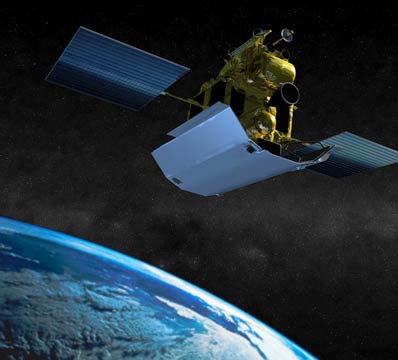
Spaceflight Now +

|

|

|

|

Premium video content for our Spaceflight Now Plus subscribers.

 Jim Kennedy, director of the Kennedy Space Center, and Col. Mark Owen, 45th Space Wing commander, hold a news conference on Monday, Sept. 27 to provide a preliminary report on damage from Hurricane Jeanne at KSC and Cape Canaveral Air Force Station. (49min 30sec file) Jim Kennedy, director of the Kennedy Space Center, and Col. Mark Owen, 45th Space Wing commander, hold a news conference on Monday, Sept. 27 to provide a preliminary report on damage from Hurricane Jeanne at KSC and Cape Canaveral Air Force Station. (49min 30sec file)
 Play audio Play audio

Hurricane Jeanne
 Cameras aboard the International Space Station captured these views of Hurricane Jeanne on Saturday, Sept. 25 as the storm approached Florida. (3min 59sec file) Cameras aboard the International Space Station captured these views of Hurricane Jeanne on Saturday, Sept. 25 as the storm approached Florida. (3min 59sec file)
 Play video Play video

Station news briefing
 International Space Station program manager Bill Gerstenmaier holds a news conference Sept. 24 to discuss problems with the oxygen generation system and Expedition 10 launch preparations. (44min 06sec file) International Space Station program manager Bill Gerstenmaier holds a news conference Sept. 24 to discuss problems with the oxygen generation system and Expedition 10 launch preparations. (44min 06sec file)
 Play audio Play audio

Galaxy clusters collide
 Scientists describe a cosmic hurricane in this news conference from Sept. 23, explaining how two merging galaxy clusters churn high-pressure shock waves that leave thousands of galaxies strewn in the wake. (53min 24sec file) Scientists describe a cosmic hurricane in this news conference from Sept. 23, explaining how two merging galaxy clusters churn high-pressure shock waves that leave thousands of galaxies strewn in the wake. (53min 24sec file)
 Play audio Play audio

Meet next station crew
 The three men to launch aboard the next Soyuz spacecraft bound for the International Space Station -- Expedition 10 commander Leroy Chiao, flight engineer Salizhan Sharipov and Russian taxi cosmonaut Yuri Shargin -- hold a pre-flight news conference near Moscow on Sept. 23. (43min 05sec file) The three men to launch aboard the next Soyuz spacecraft bound for the International Space Station -- Expedition 10 commander Leroy Chiao, flight engineer Salizhan Sharipov and Russian taxi cosmonaut Yuri Shargin -- hold a pre-flight news conference near Moscow on Sept. 23. (43min 05sec file)
 Play video Play video

Life on the station
 Former International Space Station commander Mike Foale radioed current ISS science officer Mike Fincke on Sept. 22 to discuss actvities and work aboard the outpost. (5min 01sec file) Former International Space Station commander Mike Foale radioed current ISS science officer Mike Fincke on Sept. 22 to discuss actvities and work aboard the outpost. (5min 01sec file)
 Play video Play video

Station chat with kids
 Expedition 9 commander Gennedy Padalka and flight engineer Mike Fincke talk about life aboard the International Space Station during an in-flight educational event with students at the Carnegie Science Center in Pittsburgh. (19min 00sec file) Expedition 9 commander Gennedy Padalka and flight engineer Mike Fincke talk about life aboard the International Space Station during an in-flight educational event with students at the Carnegie Science Center in Pittsburgh. (19min 00sec file)
 Play video Play video

ISS educational event
 The International Space Station's Expedition 9 crew hold an educational talk with students and members of the National Guard Bureau in Charleston, West Virginia. (19min 53sec file) The International Space Station's Expedition 9 crew hold an educational talk with students and members of the National Guard Bureau in Charleston, West Virginia. (19min 53sec file)
 Play video Play video

 Become a subscriber Become a subscriber
 More video More video

|

|

|

|

|

|

Maneuver keeps MESSENGER probe on track
MESSENGER MISSION CONTROL REPORT
Posted: September 27, 2004
MESSENGER marked its 52nd day of flight operations with a burst from its thrusters, completing a maneuver on Sept. 24 that kept it on course for next summer's Earth flyby.

Artist's impression shows MESSENGER departing Earth following its August launch. Credit: NASA/Johns Hopkins University Applied Physics Laboratory/Carnegie Institution of Washington
|
Carried out mostly by MESSENGER's four medium (5-pound) hydrazine-fueled thrusters - with a little help from 8 of its 12 small (1-pound) thrusters - the 62-second burn corrected the last remaining trajectory errors from the spacecraft's Aug. 3 launch. The short maneuver was a long-distance tap on the brakes, reducing MESSENGER's velocity by about 10 miles an hour (4.6 meters per second) relative to the Sun. MESSENGER is now more than 11.5 million miles (18.5 million kilometers) from Earth, speeding through space at 62,319 miles (100,292 kilometers) per hour.
At that distance radio signals reach Earth in just over a minute - meaning the burn, which started at 2 p.m. EDT, was effectively over when mission operators at the Johns Hopkins Applied Physics Laboratory in Laurel, Maryland, picked up MESSENGER's signals through the NASA Deep Space Network tracking station near Madrid, Spain.
MESSENGER is currently flying with its sunshade away from the Sun, allowing it to keep its instruments and systems warm without using power for heaters. The spacecraft is in good health and operating normally; subsystem and instrument tests resume today when the operations team turns on MESSENGER's instrument data processor (DPU-A) and checks its interfaces with the Magnetometer, X-Ray Spectrometer and Mercury Atmospheric and Surface Composition Spectrometer.
Visit the Mission Design section for graphics and more details on the trajectory correction maneuver. The next maneuver is planned for Nov. 18.
MESSENGER (MErcury Surface, Space ENvironment, GEochemistry, and Ranging) is a scientific investigation of the planet Mercury, and the first NASA mission designed to orbit the planet closest to the Sun. Dr. Sean C. Solomon, of the Carnegie Institution of Washington, leads the mission as principal investigator. The Johns Hopkins University Applied Physics Laboratory in Laurel, Maryland, built and will operate the MESSENGER spacecraft and manages the Discovery-class mission for NASA.
|

|

|

|
|



